System for Visualizing Surface Potential Distribution to Eliminate Electrostatic Charge
Abstract
:1. Introduction
2. Methods
2.1. Theory
2.2. Experimental Setup
3. Results and Discussion
3.1. Relationship between Signals of Sensors and Surface Potential of Samples
3.2. Scanning Speed and Accuracy of a Sensor
3.3. Validity of Surface Potential Distribution
3.4. Visualization of Contact Charging Distribution
3.5. Distribution of Charge and Dust
4. Conclusions
Funding
Institutional Review Board Statement
Informed Consent Statement
Data Availability Statement
Conflicts of Interest
References
- Lachman, L.; Lin, S.-L. Electrostatic characteristics of pharmaceutical solids and packaging materials I. Design of testing equipment and preliminary findings. J. Pharm. Sci. 1968, 57, 504–510. [Google Scholar] [CrossRef]
- Pavey, I. Pharmaceutical Technology Europe. Pharm. Technol. Eur. 1998, 10, 24–28. [Google Scholar]
- Eliasen, H.; Gjelstrup, K.; Schaefer, T. Electrostatic charging during a melt agglomeration process. Int. J. Pharm. 1999, 184, 85–96. [Google Scholar] [CrossRef]
- Voldman, S.H. ESD: Circuits and Devices; John Willey & Sons, Ltd.: Hoboken, NJ, USA, 2015. [Google Scholar]
- Cartwright, P.; Singh, S.; Bailey, A.G.; Rose, L.J. Electrostatic Charging Characteristics of Polyethylene Powder during Pneumatic Conveying. IEEE Trans. Ind. Appl. 1985, IA-21, 541–546. [Google Scholar] [CrossRef]
- Glor, M. Electrostatic Hazards in Powder Handling; Research Studies Press Ltd.: Taunton, UK, 1988. [Google Scholar]
- Harland, D.M.; Lorenz, R.D. Space Systems Failures; Plaxis Publishing Ltd.: Chichester, UK, 2005. [Google Scholar]
- Murata, Y.; Hiyoshi, I. Characteristics of Photoemission of High Polymers. Jpn. J. Appl. Phys. 1997, 36, 5329–5334. [Google Scholar] [CrossRef]
- Devins, J.C.; Reynolds, S.I. Rotating Probe Electrometer. Rev. Sci. Instr. 1957, 28, 11–13. [Google Scholar] [CrossRef]
- Foord, T.R. Measurement of the distribution of surface electric charge by use of a capacitive probe. J. Phys. E. Sci. Instrum. 1969, 2, 411–413. [Google Scholar] [CrossRef]
- Matsui, M.; Fujibayashi, K.; Matsuoka, G.; Murasaki, N. Sensitivity of a vibrating electrode type field meter driven at ultrasonic frequency. J. Electrostat. 1999, 46, 131–141. [Google Scholar] [CrossRef]
- Secker, P.E. The desing of simple instruments for measurement of charge on insulating surfaces. J. Electrostat. 1975, 1, 27–36. [Google Scholar] [CrossRef]
- Kuriyama, T.; Aoi, T.; Maeda, H.; Itoh, T.; Ueno, Y.; Nakaie, T.; Matsui, N.; Okumura, H. Desing of Opical System for Electrostatic Field Distribution Measurement Using Micromirror Array. Sens. Mater. 2011, 23, 435–448. [Google Scholar]
- Kobayashi, T.; Oyama, S.; Makimoto, N.; Okada, H.; Itoh, T.; Maeda, R. An electrostatic field sensor operated by self-excited vibration of MEMS-based self-sensitive piezoelectric microcantilevers. Sens. Actuator A Phys. 2013, 198, 87–90. [Google Scholar] [CrossRef]
- Kikunaga, K.; Hoshi, T.; Yamashita, H.; Fujii, Y.; Nonaka, K. Measuring Technique for Static Electricity Using Focused Sound. J. Electrostat. 2013, 71, 554–557. [Google Scholar] [CrossRef]
- Kikunaga, K.; Yamashita, H.; Fujii, Y.; Nonaka, K. Measurement Technology of Surface Potential Using Acoustic Wave and Electric Field. Jpn. J. Appl. Phys. 2013, 52, 05DB16-1–05DB16-5. [Google Scholar] [CrossRef]
- Kikunaga, K.; Nonaka, K. Generation and detection of electromagnetic field with charged material oscillation. J. Electrostat. 2014, 72, 136–139. [Google Scholar] [CrossRef]
- Molinie, P. Measuring and modeling transient insulator response to charging: The contribution of surface potential studies. IEEE Trans. Dielectr. Electr. Insul. 2005, 12, 939–950. [Google Scholar] [CrossRef]
- Llovera, P.; Molinié, P.; Soria, A.; Quijano, A. Measurements of electrostatic potentials and electric fields in some industrial applications: Basic principles. J. Electrostat. 2009, 67, 457–461. [Google Scholar] [CrossRef]
- Reznikov, M.; Noras, M.; Salazar, M. Comparison of vibrating and fixed Kelvin Probe for non-destructive evaluation. J. Electrostat. 2018, 96, 57–63. [Google Scholar] [CrossRef]
- Kachi, M.; Dascalescu, L.; Herous, L.; Nemamcha, M. Experimental study of charge neutralization at the surface of granular layers of insulating materials. IEEE Trans. Ind. Appl. 2013, 49, 691–698. [Google Scholar] [CrossRef]
- Takuma, T.; Yashima, M.; Kawamoto, T. Principle of surface charge measurement for thick insulating specimens. IEEE Trans. Dielectr. Electr. Insul. 1998, 5, 497–504. [Google Scholar] [CrossRef]
- Kikunaga, K.; Hoshi, T.; Yamashita, H.; Egashira, M.; Nonaka, K. Development of a technique for measuring static electricity distribution using focused ultrasound waves and an induced electric field. J. Electrostat. 2015, 73, 6–11. [Google Scholar] [CrossRef]
- Terris, B.D.; Stern, J.E.; Rugar, D.; Hamin, H.J. Contact electrification using force microscopy. Phys. Rev. Lett. 1989, 63, 2669–2672. [Google Scholar] [CrossRef] [PubMed]
- Schönenberger, C.; Alvarado, S.F. Observation of single charge carriers by force microscopy. Phys. Rev. Lett. 1990, 65, 3162–3164. [Google Scholar] [CrossRef]
- Saurenbach, F.; Terris, B.D. Electrostatic writing and imaging using a force microscope. IEEE Trans. Ind. Appl. 1992, 28, 256–260. [Google Scholar] [CrossRef]
- Uehara, T.; Higashio, J.; Ashizawa, Y.; Aizawa, K.; Nakagawa, K.; Itoh, A. Real time observation of surface potential distribution with an EFM on CTL. IS&T’s NIP25. In Proceedings of the International Conference on Digital Printing Technologies, Louisville, KY, USA, 20–24 September 2009; pp. 212–215. [Google Scholar]
- Itoh, T.; Nakaie, T. Field Programmable Gate Array-based Real-Time Visualization System of Electrostatic Field Distribution Measurements Using a Microelectromechanical Systems Micromirror Array. IEEJ Trans. Sens. Micromach. 2018, 138, 74–78. [Google Scholar] [CrossRef]
- Kikunaga, K.; Terasaki, N. Detection of Moisture Adsorption on Joining Surface Using Static Electricity Distribution. ECS Trans. 2017, 75, 33–38. [Google Scholar] [CrossRef]
- Kikunaga, K.; Terasaki, N. Characterization of electrical conductivity of carbon fiber reinforced plastic using surface potential distribution. Jpn. J. Appl. Phys. 2018, 57, 04FC02. [Google Scholar] [CrossRef] [Green Version]
- Fatihou, A.; Dascalescu, L.; Zouzou, N.; Neagoe, M.B.; Reguig, A.; Dumitran, L.M. Measurement of surface potential of non-uniformly charged insulating materials using a non-contact electrostatic voltmeter. IEEE Trans. Dielectr. Electr. Insul. 2016, 23, 2377–2384. [Google Scholar] [CrossRef]
- Neagoe, M.B.; Prawatya, Y.E.; Zeghloul, T.; Dascalescu, L. Electric-potential-measurement-based methodology for estimation of electric charge density at the surface of tribocharged insulating slabs. J. Electrostat. 2017, 90, 123–130. [Google Scholar] [CrossRef]
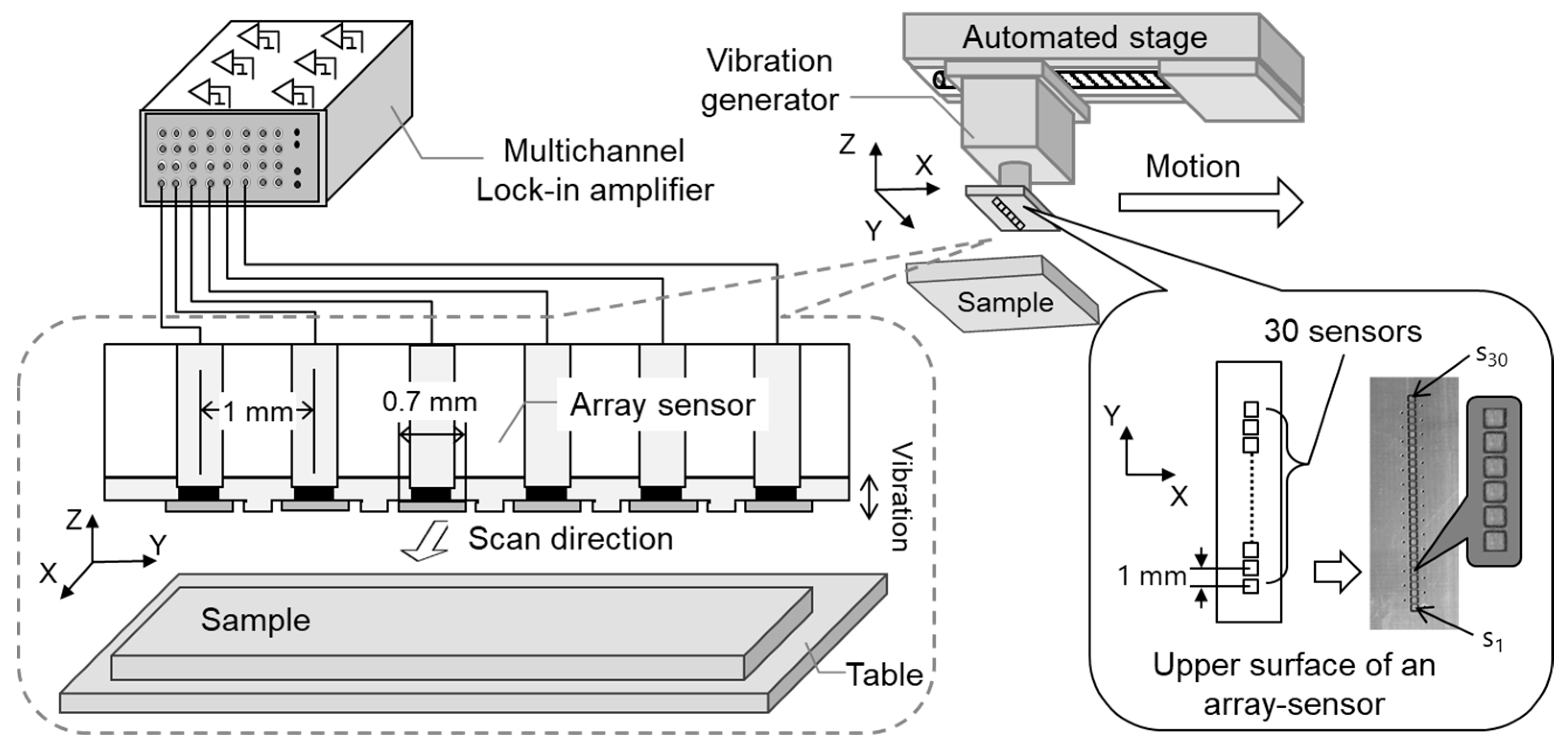

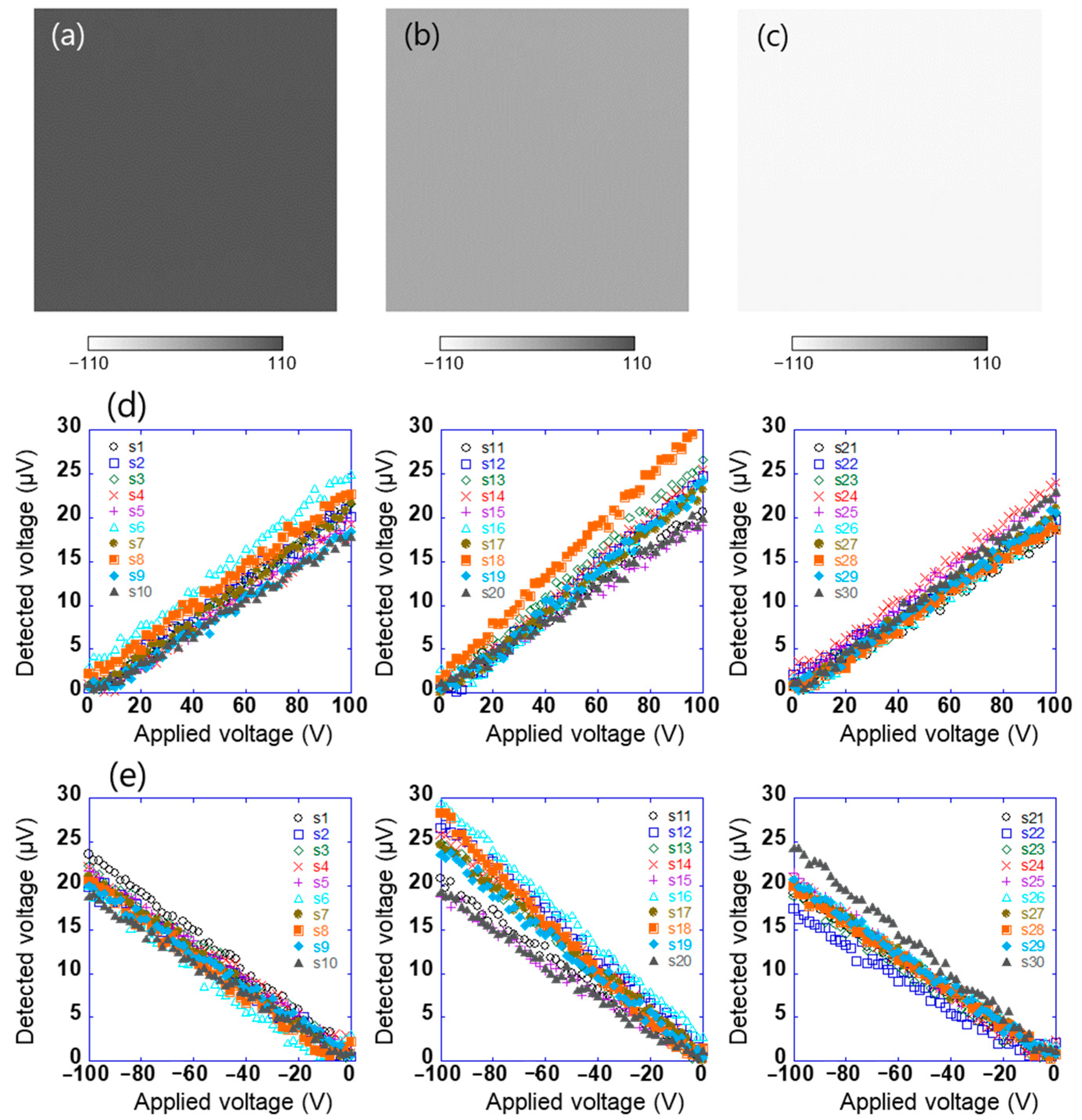


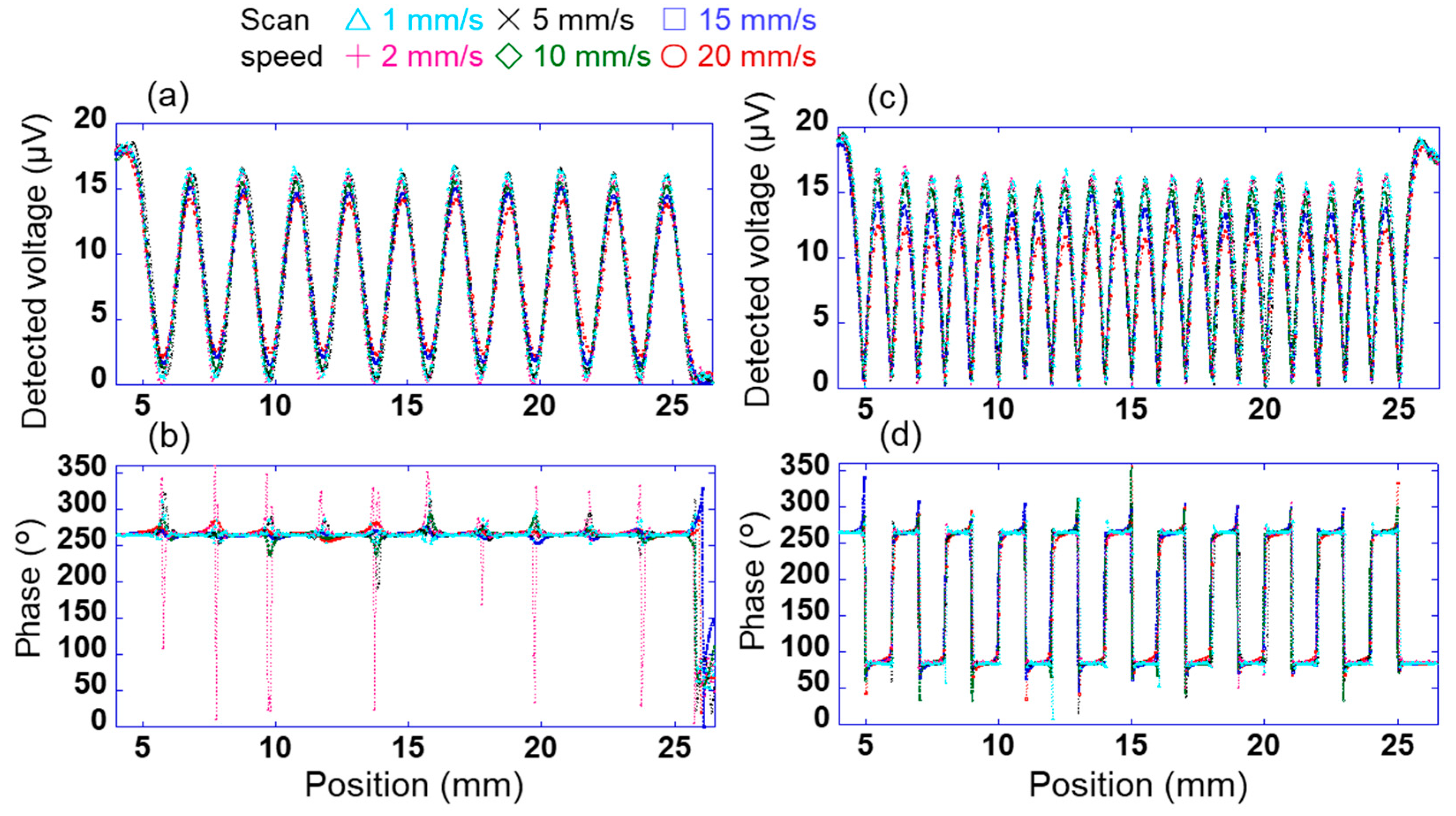

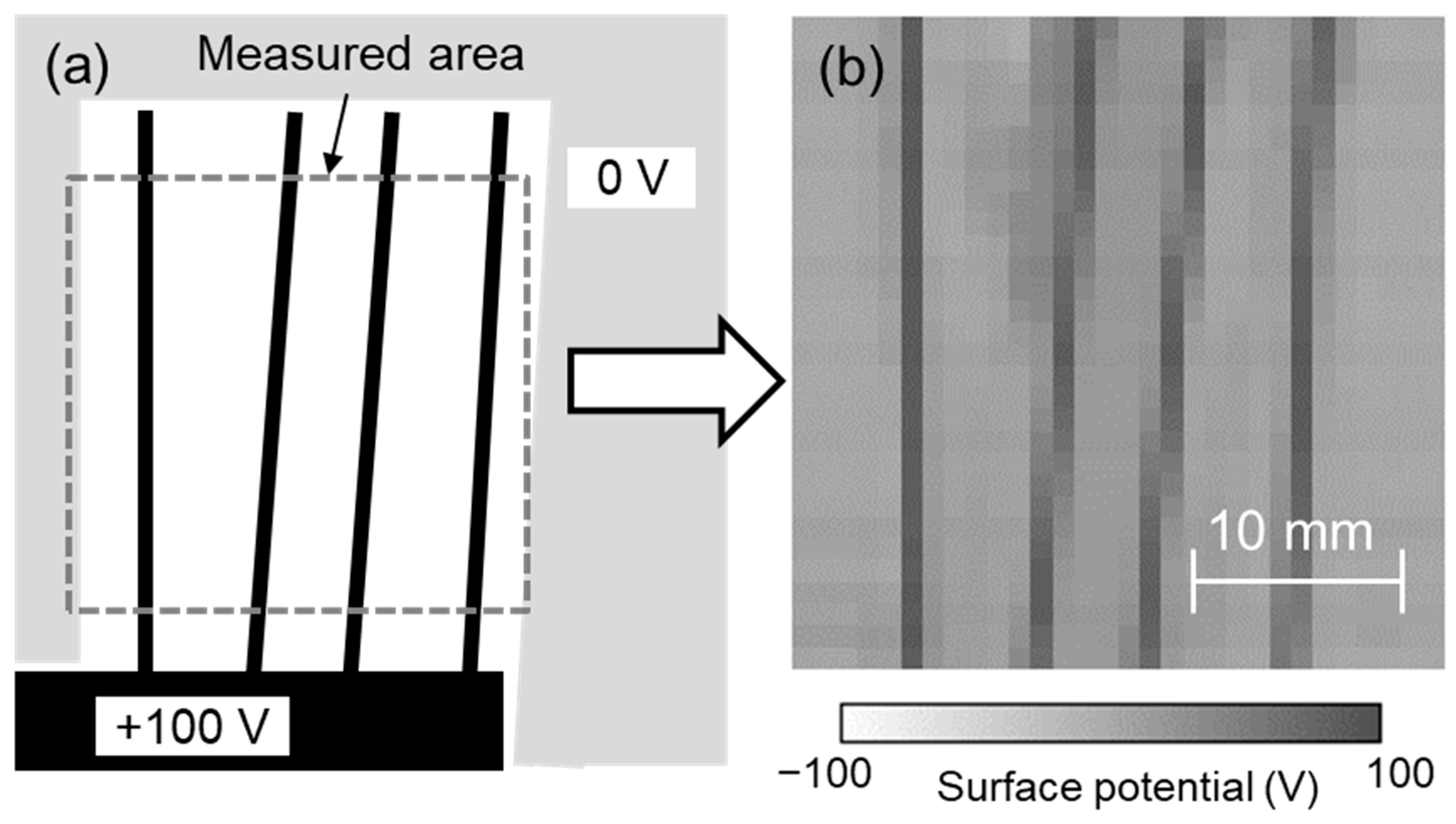
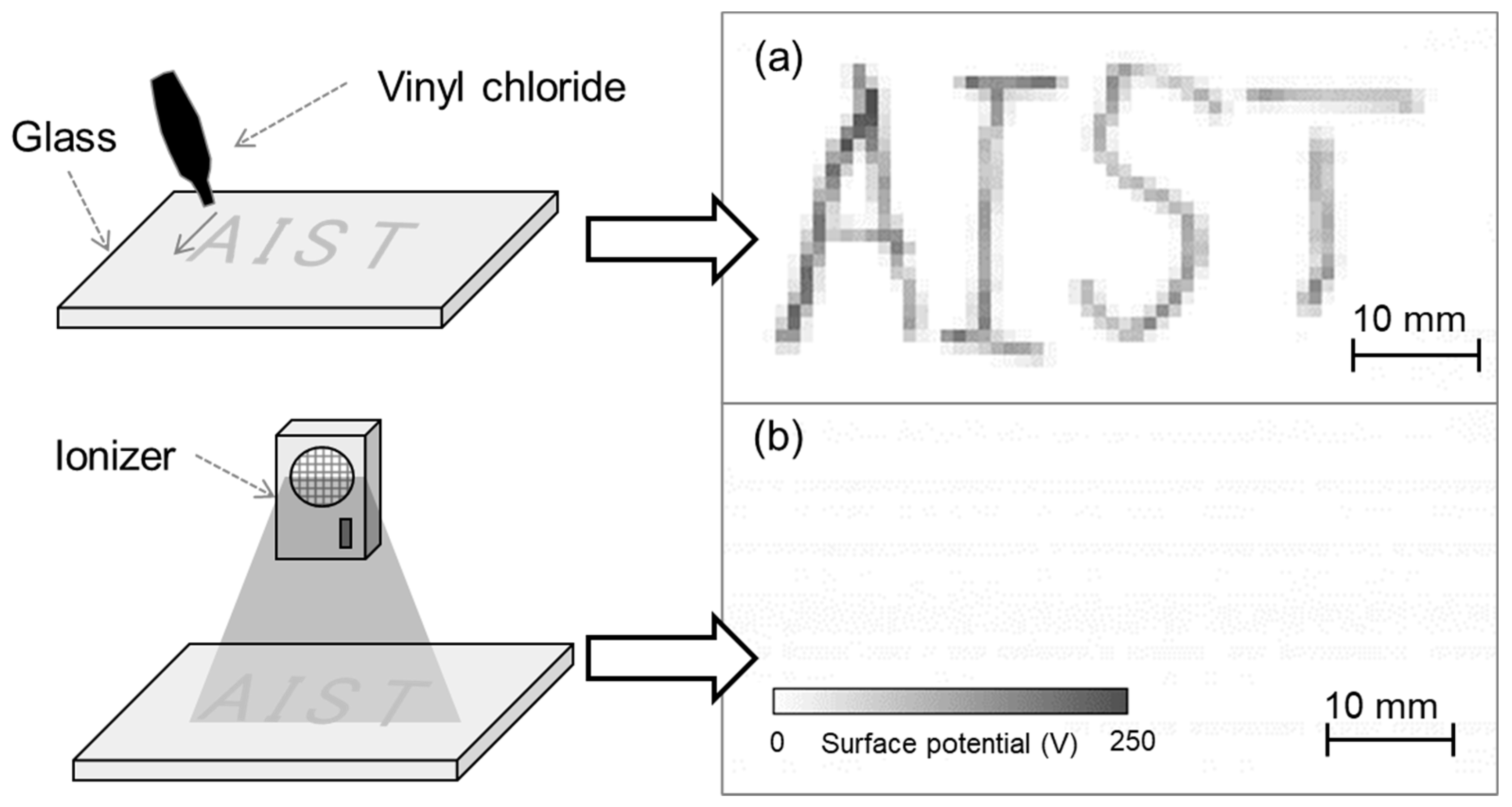
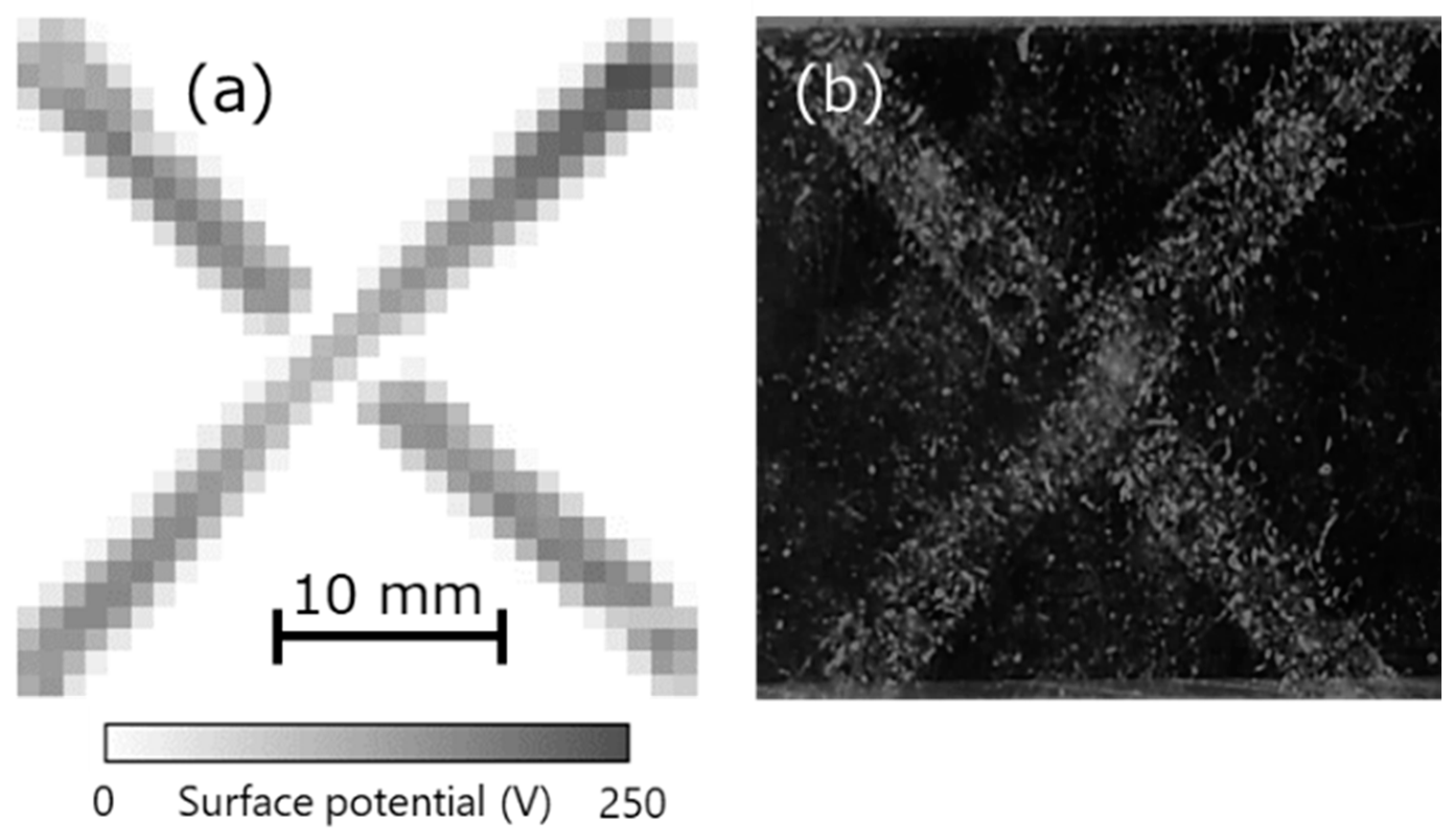
Publisher’s Note: MDPI stays neutral with regard to jurisdictional claims in published maps and institutional affiliations. |
© 2021 by the author. Licensee MDPI, Basel, Switzerland. This article is an open access article distributed under the terms and conditions of the Creative Commons Attribution (CC BY) license (https://creativecommons.org/licenses/by/4.0/).
Share and Cite
Kikunaga, K. System for Visualizing Surface Potential Distribution to Eliminate Electrostatic Charge. Sensors 2021, 21, 4397. https://doi.org/10.3390/s21134397
Kikunaga K. System for Visualizing Surface Potential Distribution to Eliminate Electrostatic Charge. Sensors. 2021; 21(13):4397. https://doi.org/10.3390/s21134397
Chicago/Turabian StyleKikunaga, Kazuya. 2021. "System for Visualizing Surface Potential Distribution to Eliminate Electrostatic Charge" Sensors 21, no. 13: 4397. https://doi.org/10.3390/s21134397





